
Equipment
Apparatus by committee
All firefighters have opinions about the trucks (and everything else!) in their departments.
November 12, 2013
By Ryan Pennington and Laura King
All firefighters have opinions about the trucks (and everything else!) in their departments. So how do firefighters share their thoughts about new truck purchases without sounding critical? And how can management best involve crews in the truck-specing process to get their street-level perspectives?
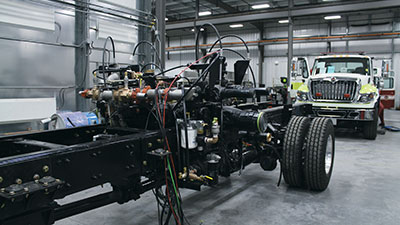 |
|
| Including a rookie on the apparatus committee forces other members to explain all their ideas, says one fire chief. Photos by ROB EVANS
|
With more and more options available on today’s trucks, and fewer municipal dollars for big budget items, the specing process is crucial: these decisions can affect your department for years to come.
For firefighters, being given an opportunity to provide opinions and ideas means offering solutions rather than complaints: taking time to research ideas and offer suggestions in a non-threating way will ensure that their voices are heard.
For management, involving firefighters in the purchasing plan can boost morale, and requesting input from those who use the equipment daily can result in a more well-rounded plan of action.
“On a small department likes ours,” says Fire Chief Rob Evans of Redwood Meadows Emergency Services (RMES) in Alberta, “everybody’s opinion can be worth its weight in gold.”
Evans is a volunteer chief of a busy volunteer department, where keeping members engaged is crucial.
“I believe it’s important to recruitment and retention efforts as well,” Evans says. “If your members have been a part of designing apparatus, there’s more pride and ownership and a desire to stick around.”
But there can be risks when management brings firefighters into the buying process: potential backlash against firefighters perceived to be too close to management, for example, or lack of consensus when there are too many voices.
Fire Chief Tom DeSorcy in Hope, B.C., has participated in the purchase of seven trucks over several years – both as a firefighter and as a chief.
Years ago, a department that is now part of the District of Hope needed a new tanker. Or so its members thought.
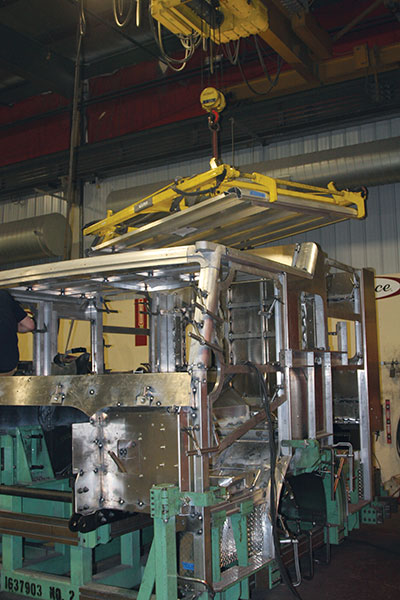 |
|
| However, it is also important to stay on budget and make sure the department’s needs are put ahead of individual preferences.
|
“We formed a committee,” DeSorcy says, “consisting of a few of us and the fire chief. With no experience and $150,000 in our back pocket we went shopping. We soon realized that a tanker was not what we needed but a new pumper, so we went back to council and secured the necessary funding. That was when the entire hall got involved. The ensuing situation wasn’t pretty and centred around two issues: the placement of the pump panel and the logo on the door.”
A new truck with a transverse-mounted pump control would have been too long to fit in the hall, so the committee proposed a side-mounted pump.
“In those days, DeSorcy says, “incident command was non-existent and the pump operator liked to run the scene from the top of the truck.”
With a side-mounted pump panel, the operator wouldn’t be able to see the fire scene.
“It became quite an argument,” DeSorcy said, “with all members of the department involved to the point at which I said, let’s settle this once and for all and vote.”
A transverse-mounted pump was chosen, the chief resigned, and the builder had to fabricate a retractable tailboard so the truck would fit into the hall.
So, what’s the best way to get quality input from firefighters?
Fire chiefs say it’s important that the chief define the department’s needs and determine the type of truck that is needed before soliciting input from others. And, they say, it’s crucial that the department’s needs come before individual preferences.
“In our department,” says Fire Chief Gord Schreiner of Comox, B.C., “the fire chief sets the overall goal and then we put together a truck committee to design the finer details on a new rig.”
The committee consists of an assistant chief, a captain, a lieutenant, two firefighters and a brand-new recruit.
“We feel by having a broad-based committee like this that most issues are addressed in terms of how the rig will function,” Schreiner says.
“By adding a new recruit to the mix, the committee is forced to explain things as they go. The thought is if they can explain to the recruit why we need what we are asking for, then we will have a better chance of explaining these things to politicians and other citizens.”
In addition, Schreiner says, having a recruit on board demonstrates the department’s commitment to its members and the equipment they will use.
Chief Lyle Quan of Waterloo, Ont., agrees that rank-and-file firefighters have a lot to offer the purchasing committee.
“I believe in letting the people who use the equipment build the truck and look at how it needs to be designed to be user friendly for all,” he says.
“As for the fire chief’s role, it’s more about getting the right piece of apparatus for the right job at the right price. When I’m told that we have a certain amount to spend on the apparatus, then I ensure that the truck committee understands that these are the financial parameters that they must work under.
“Our firefighters are very smart and creative people and they get that there isn’t a bottomless well of money, so create the best of equipment you can with the funds available and design it so it will last.”
Brad Petrie, internal sales manager with Fort Garry Fire Trucks, says working with an apparatus committee of the Winnipeg Fire and Paramedic Service over the last two years on the purchase of eight trucks was the most positive experience he has had as a salesperson.
“We dealt with Winnipeg seven or eight years ago on two smaller trucks,” Petrie says. “There were management people from different areas – the union, maintenance, a deputy chief; we had guys in a room who couldn’t make a decision on the colour of a truck.”
Overall, says Petrie, buying trucks by committee can be a challenge; having a committee leader who understands best practices is a big help.
“We’d get a contract, guys would come in and discuss the truck; it’s hard to get a decision made – guys from each different area were trying to get their point across and to get a decision made was very difficult to do. There was a lot of internal politics.”
This time, Petrie says, Winnipeg Capt. Don Enns approached the committee and the $3.6 million purchase from a project-management perspective.
“With Don’s committee, everything was prepared; they knew what they wanted to do.”
Enns’ committee included three captains, one lieutenant, three firefighters, one training officer and one heavy duty fire apparatus mechanic.
Enns says the committee’s mandate was to be on time, within scope and under budget.
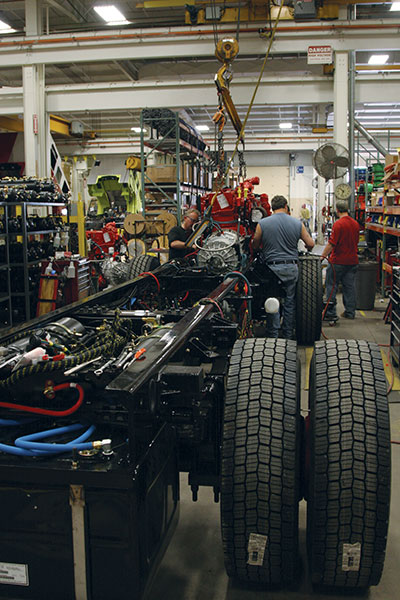
|
|
| For firefighters, offering solutions rather than complaints is the best way to have input on new truck purchases taken seriously. |
“It was a phenomenal opportunity and turned out to be a delightful experience and that was because we managed to develop a phenomenal rapport,” Enns says. “We also had two firefighters there from the United Fire Fighters of Winnipeg join us to observe – wanted the union’s input on it. And the project sponsor was deputy chief, who I reported to directly.”
In addition, Enns says, the committee brought in subject-matter experts from Winnipeg’s fleet management team.
Enns says the key to the committee’s success was involving firefighters who use the equipment every day.
“The trick,” he says, “is to give the guys something that they’re proud of and they’ll take better care of it. When they take pride in it and ownership of it, that’s the greatest feeling in the world – machines designed by firefighters, for firefighters, being used by firefighters.”
For example, Enns says, on the eight new trucks, the attack lines were lowered to about 42 inches.
“Now instead of having firefighters reaching up and pulling, they are now pulling at waist height.”
Backboards, stretchers, and the rear hosebeds were also lowered for easier access, and the truck’s ladders were enclosed.
“Winnipeg has one of worst, most physically demanding climates in the country,” Enns says. So to have the ladders enclosed helps with access and safety. “These ideas came from the firefighters,” he said.
Petrie says departments preparing to buy trucks should talk to others that have had successful buying experiences.
“There are a lot of guys coming into this that aren’t used to buying a fire truck,” he says. “They don’t understand that it’s not like going out and buying a car at a dealership. Each truck is different in each different region – in B.C. you’ve got hills and mountains, versus Winnipeg, where it can be -40. It’s like building a house – there’s a lot of customization going into it. That’s why Winnipeg got the truck they ultimately wanted – because they got the guys who use the equipment, instead of the higher ups that don’t use the equipment – and that was the biggest difference.”
The higher ups, of course, had a say in the matter, Enns notes but says the committee was not micro managed.
“The senior management team were our advocates,” Enns says. “Our chiefs at the time were our biggest fans. They set us up for success. They allowed us to do our jobs.”
For firefighters, then, what are the dos and don’ts of getting involved? And how can firefighters best offer input in a constructive way?
Firefighters are always searching for the perfect configuration for a fire truck. Whether it’s the turning radius or the hose-bed configuration, firefighters need to be prepared to offer well-researched options. If you show up with solutions, your opinion will be heard. If you produce a list of complaints without resolutions, you will quickly find yourself outside cleaning the tar off the bottom of the antique fire truck. Maybe not, but you get the point.
If you determine that a change is needed on your next truck, take the time to make your concern known to your fellow firefighters and ask their opinions. Is your issue truly a problem area or is it just your pet peeve? Firefighters have strong opinions on just about every topic around the fire hall. Heck, firefighters can argue over what type of floor soap is the best, never mind improvements to apparatus design.
Identification of these issues should be handled tactfully. Emotions can run high if the firefighter or apparatus committee member who chose the option that you find frustrating perceives your idea to be a negative response to his work. Simple questions can help you understand the reasons behind your area of concern.
Say you find it difficult to retrieve the six-foot hook from its place in the apparatus compartment because the hook is mounted quite high up. If you explain to others that you find it challenging to retrieve the hook at fire scenes, you can then ask why the hook is mounted so high. You may be surprised to find out that this is because there is no other compartment long enough to fully enclose the hook.
If you are non-confrontational about the inquiry, you will be able to find out why things are as they are and understand without offending anyone. This is also the point at which you can start an investigation into or conversation about a better place to mount the hook. This type of language works well: “Firefighter Joe, I understand why you placed the hook up so high, but we are having problems retrieving it. Can we look into another mounting choice for our next rig?”
In this simple statement you have identified a problem, showed that you understand why the current configuration was chosen, and invited your colleagues to collaborate on a solution. This shows your genuine interest in a finding common solution, and does not involve finger pointing.
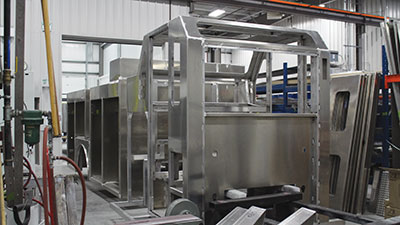 |
|
| Starting research long before the department plans to buy a new truck is a must in order to get the best information from other departments.
|
Now that you have identified an area for improvement, it’s time to focus in on the solution. Start searching the Internet to find out how other departments have handled your area of concern. Your research should include North America, the United Kingdom, Europe and Australia – all areas in which you will find fire departments that are leaders in firefighter safety.
If you find a fire department that seems to have an answer to your issue, reach out to its members: their research and opinions could prove invaluable. Most departments, manufacturers and designers love to share their design successes and are often are the first ones to admit when an area needs improvement. Be sure to document everything – particularly whom you spoke to and when, so you can follow up if need be – and ask for additional contact information so you can verify your findings if you are pressed to do so by your department’s truck committee or your chief.
It is also a good idea to have a standard set of questions ready when you call so that you’re asking the same questions all the time. Keeping good records of these conversations will help to bolster your position should you be seeking a change.
RMES Chief Evans says research should be started well in advance of any truck purchase.
“Research for our new rescue started over two years before the truck was ordered,” Evans says. “This allowed time for our crews to research and where possible test different equipment we were looking at for the truck.”
For Chief Tom Bremner on Salt Spring Island in British Columbia, firefighter input is a necessary part of the design process.
“I have personally used the combined apparatus committee concept, from coast to coast, on four occasions with a positive outcome,” says Bremner, who was the chief in Truro, N.S., before moving west.
He says the combined committee structure allows for multiple levels of experience; majority buy-in from the membership, the community and council; and a well-researched truck proposal.
“It is absolutely wrong to think one person or a few well-meaning people without any expertise can understand, design, or manage a modern-day fire apparatus draft,” Bremner says.
Fire Chief Les Karpluk of Prince Alberta, Sask., found that a firefighter on his ladder-truck committee provided a fresh perspective and saved the department money.
“When we put out our tender for our ladder truck, I created a truck committee, which included one firefighter,” Karpluk says. “The intention was to have a firefighter with the floor experience to give input into how we designed our new ladder truck.
“We travelled to three different manufacturing facilities – Sutphen, Pierce and Rosenbauer – in the United States, and took extensive notes and photos.”
The firefighter, Karpluk says, took it upon himself to “drill down” into each of the three manufacturers and how they built their trucks.
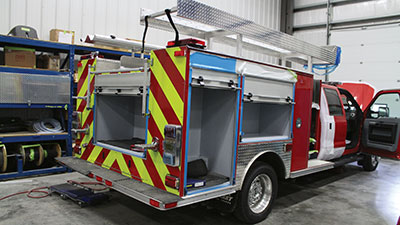 |
|
| Firefighters who want to participate in truck-buying decisions need to do their homework and make well-rounded presentations in writing, or even through videos, to prove that their ideas are valid. Photo courtesy of Fort Garry fire trucks |
“He spent an extensive amount of time looking at compartment configurations, interior design of the cabs, and how each ladder operated. By the time we were getting into the details of how the compartments were laid out, I just let him run with it. Yes, there were times when what he suggested would cost us money but I will never forget his words: ‘Chief, this is something that will work well for the guys.’
“And, based upon his experience and focus on our ladder truck, I approved his requests, because they made sense. There was not one occasion when he requested something because it was bling. He was totally focused on changes that would make it easier and safer to perform duties as a firefighter.”
Karpluk says that although involving the firefighter on the committee cost the department some extra travel and overtime dollars, the firefighter’s ideas actually resulted in a less pricey apparatus.
“He actually saved us money in the long run and I am extremely grateful for his foresight,” Karpluk says. “He came up with ideas that I would never have thought of because I am too busy behind the desk, working to get the money for these big rigs.”
“Without a doubt,” Karpluk says, “the input from our firefighter helped my department get a ladder truck that will be serving the city for the next 20 years.”
Now that you have identified a problem, done you homework, and come up with a solution, it’s time to prepare your proposal. You need to organize your solution in a form that can be presented to the leadership of the department or the truck committee. You must arrange the proposal in writing with direct quotes and the suggestions from the departments from which you gathered the information; this increases your credibility and provides the committee with an opportunity to reach out to those from whom you got your information to further investigate. Hearing the solutions directly from the departments you contacted will help to validate your claims. If your proposal seems valid, well researched and reasonable, the committee might just take your word for it.
If you are not good with a written delivery, gather photos or provide audio recordings of your conversations (with the permission of the other departments, of course). Videos are worth a million words and the little bit of extra work will show your chief or the committee your commitment to problem solving. Also, showing the solution in action can go a long way to making your proposal a reality.
Print this page